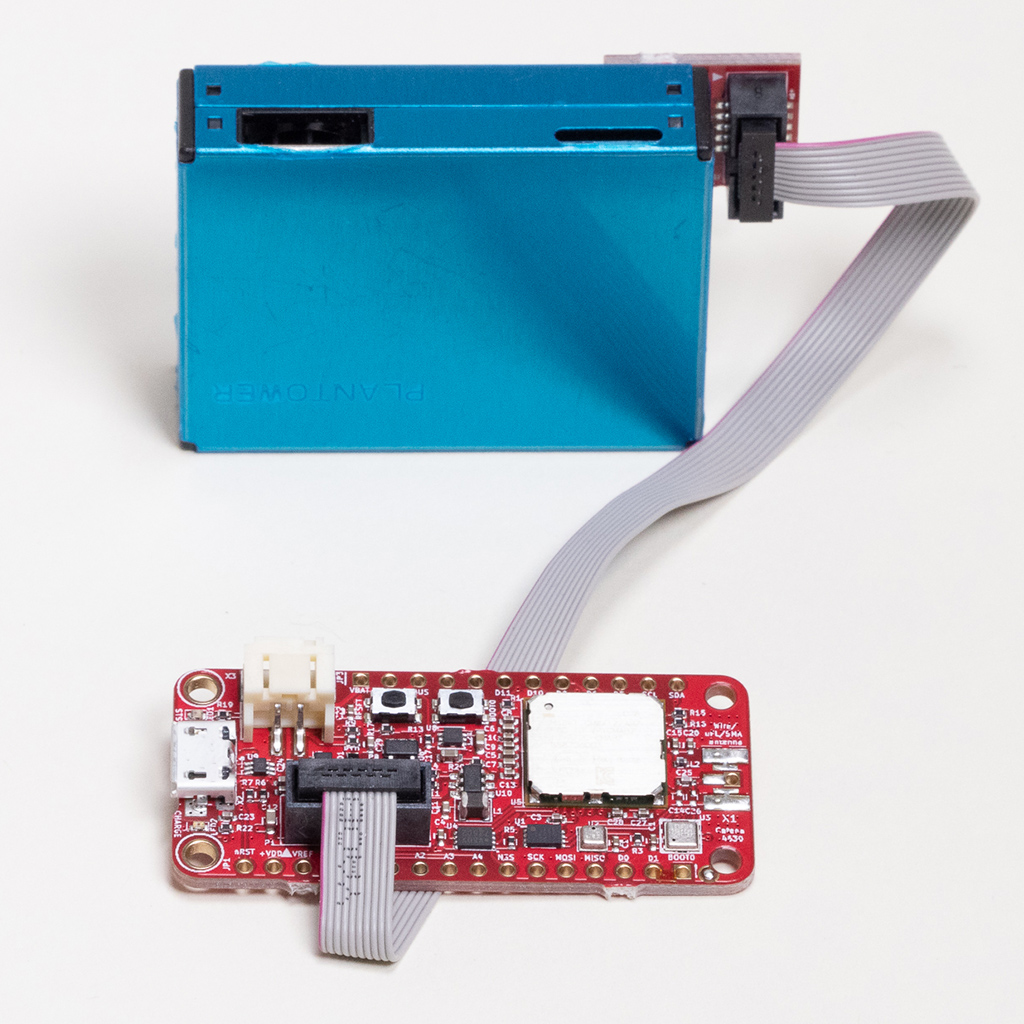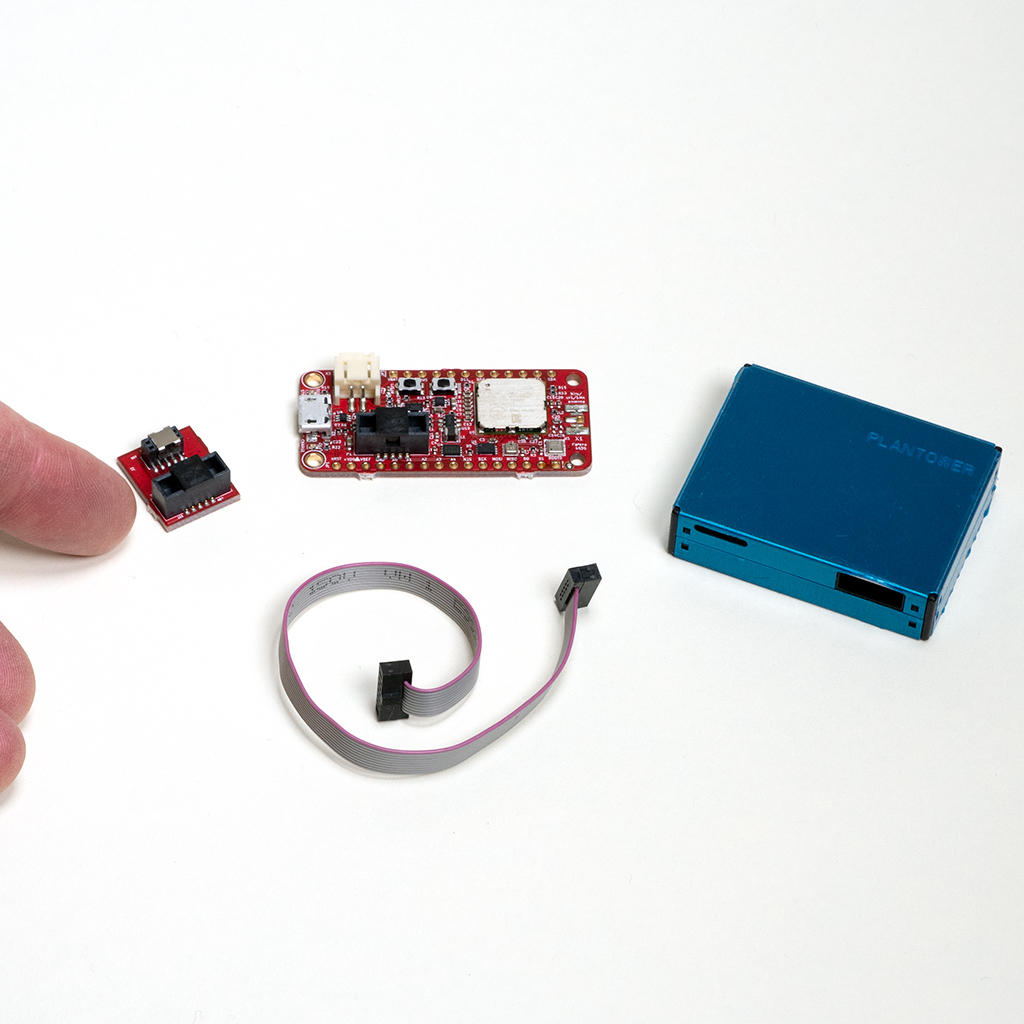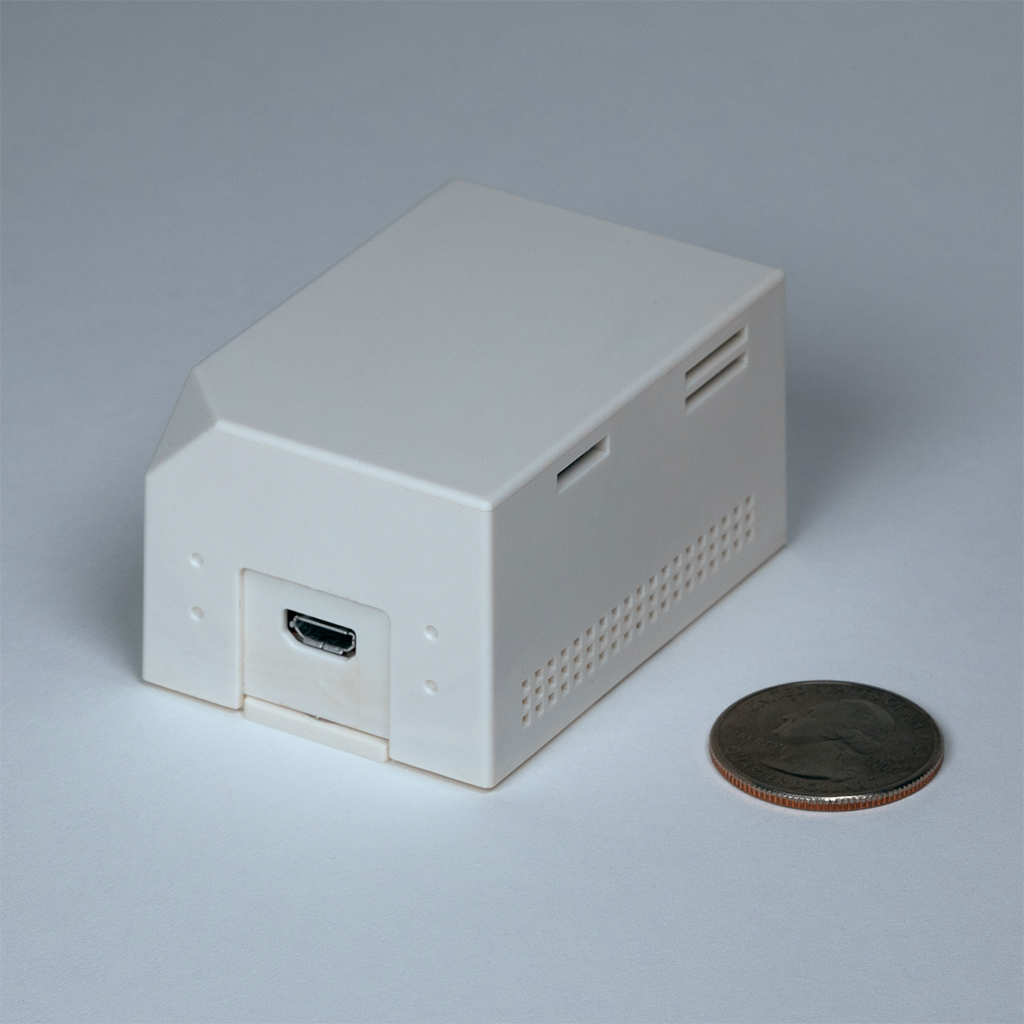MCCI PMS7003 Library
This library provides a structured interface to a Plantower PMS7003 particulate matter sensor. An example demonstrates the functionality of the PMS7003 with the MCCI Catena 4630 Air-Quality Sensor. This library is also used in the software for the MCCI Model 4841 Air Quality Sensor.
 |
 |
 |
- Introduction
- Header Files
- Library and Board Dependencies
- Namespace
- Instance Objects
- Key classes
- Integration with Catena 4630
- Example Sketches
- Additional code for dashboards
- Useful references
- Board Support Dependencies
- Other Libraries and Versions Required
- Meta
Introduction
The Plantower PMS7003 sensor is a laser-scattering-based particle concentration sensor. It returns two kinds of data:
- Particle concentrations for 1.0, 2.5 and 10 micron particles, expressed as μg/m^3; and
- Dust concentrations for 0.3, 0.5, 1.0, 2.5, 5, and 10 micron particles, expressed as count/0.1 L of air.
Particle concentrations are expressed in terms of mass/volume; dust concentrations are expressed in terms of count/volume.
This library provides a framework for operating the PMS7003 in an Arduino environment.
Here's the basic UML class diagram.
cPMS7003 is the class for instances of the PMS7003 sensor. As the diagram shows, it's a cPollableObject, so it will get polled along with everything else.
The class is intended to be portable; so instead of directly talking to hardware, it uses an associated HAL object and an abstract class cPMS7003Hal. The library supplies a concrete HAL implementation class, cPMS7003Hal_4630, which can be used on a Catena 4630.
Header Files
<Catena-PM7003.h>is the header file for thecPMS7003class.<Catena-PMS7003Hal.h>is the header file for thecPMS7003Halclass.<Catena-PMS7003Hal-4630.h>is the header file for the concrete HAL for the 4630,cPMS7003Hal_4630.
Library and Board Dependencies
Because the main class cPMS7003 uses McciCatena::cPollableObject, the Catena Arduino Platform must be available.
The example sketch targets the Catena 4630 and won't run on other hardware without modification.
Namespace
The contents of the library are all in namespace McciCatenaPMS7003. We recommend you insert the following line after including the header files.
using namespace McciCatenaPMS7003;Instance Objects
To use this library, you must create two instance object.
HAL instance object
You must create a HAL instance object to use this library. Don't try to instantiate an object of type cPMS7003Hal. It's an abstract class and can't be instantiated. Instead, instantiate an object from a concrete HAL class such as cPMS7003Hal_4630. The rules for instantiation are set by the concrete class; in this case, you need two arguments. The first argument is an lv that resolves to a McciCatena::Catena4630 object. The second argument gives the initial value for the debug flags (see the debugmask command).
cPMS7003 instance object
You must create a PMS7003 instance object. For example:
cPMS7003 gPms7003 { Serial2, gPmsHal };Key classes
cPMS7003Hal
This is the abstract class which provides the HAL for the cPMS7003 library. This is not modified for porting, unless we discover that it is insufficiently abstract.
cPMS7003Hal_4630
This is the concrete HAL implementation for using the library on the Catena 4630. If porting to another platform, you will want to copy this (with a different name), and modify the method functions as appropriate.
cPMS7003
This class models the low-level hardware of PMS7003 PM2.5 sensor. The class is partially abstract, in that it expects a wrapper class to provide virtual overrides for power control and the GPIOs. It uses the cPollableObject paradigm to drive accumulation of data from the sensor.
It models the device with an FSM shown in the next figure.
Features of this FSM:
- The PMS7003 is initially powered down.
- When a wake event is received from the application, the FSM powers up the PMS7003 and takes it through a wakeup sequence. Data received while in the warmup state is indicated up to the client, but tagged as warming up.
- Once the library has finished the warmup sequence, it allows the client to operate the PMS7003 in "normal" mode (where the PMS7003 sends data spontaneously as it sees fit), or in "passive" mode (where the application must request a measurement).
- At any time, the client may power down or reset the PMS7003.
- While the PMS7003 is active, the client may select a low-power sleep mode, either via a hardware sleep (using the SET pin) or a software sleep (using a command).
- Waking up the PMS7003 from sleep is the same as starting from power off; it must go through a warmup cycle. However, the timing for waking from sleep is much more deterministic. Starting from power off takes anywhere from 5 to 45 seconds (empirically determined); starting from sleep takes about 3 seconds to the first warmup message, and about 12 seconds to full operation.
cPMS7003::Measurements<>
The PMS7003 sends three groups of measurements in each data set.
-
It sends atmospheric particulate matter concentrations binned by particle size: 1.0 micron, 2.5 micron and 10 micron particles. The units of measurement are μgrams per cubic meter of air.
-
It sends dust concentrations, also binned by particle size: 0.3, 0.5, 1.0, 2.5, 5 and 10 microns. The units of measurement are particle counts per deciliter of air.
-
It sends "factory" concentrations of particulate matter, binned by particle size as for atmospheric concentrations. These readings are typically only used for factory calibration and test.
The library defines structure templates for conveying this information. The template cPMS7003::PmBins<typename NumericType> represents the three bins in a single structure with fields m1p0 for PM1.0 concentrations, m2p5 for PM2.5 concentrations, and m10 for PM10 concentrations. The library reports data using cPMS7003::PmBins<std::uint16_t>.
If you are not familiar with templates, think of them as C++-aware macros. For example, the template for
PmBins<>is:template <typename T> struct PmBins { T m1p0; // PM1.0 concentration ug/m3 T m2p5; // PM2.5 concentration ug/m3 T m10; // PM10 concentration ug/m3 };
Tis a parameter, which must be a type. When we writePmBins<uint16_t>, the compiler generates a structure by substituting<uint16_t>forT. So we get:struct { uint16_t m1p0; // PM1.0 concentration ug/m3 uint16_t m2p5; // PM2.5 concentration ug/m3 uint16_t m10; // PM10 concentration ug/m3 };We could do this with C preprocessor macros, but templates allow the compiler to understand what's intended, in a way that's not possible with C macros.
Two other templates are defined by the library. cPMS7003::DustBins<> similarly creates a structure representing the dust bins. The fields are named m0p3, m0p5, m1p0, m2p5, m5, and m10, corresponding to 0.3, 0.5, 1.0, 2.5, 5, and 10 micron particles.
The measurements (atmospheric, dust, and factory) are combined in a large structure, cPMS7003::Measurements<>. This contains the subfields atm and cf1 (both PmBins), representing atmospheric and factory particulate matter measurements, and dust (an instance of DustBins).
Using templates, it's easy to generate a measurement structure using float or uint32_t; for each entry; just write cPMS7003::Measurements<float>,
cPMS7003::Measurements<uint32_t>, etc.
Integration with Catena 4630
The Catena 4630 has the following features.
-
LoRaWAN-compatible radio and software
-
Bosch BME280 temperature/humidity/pressure sensor
-
IDT ZMOD4410 gas sensor
-
Interface to external Plantower PMS7003 particulate matter sensor, including 5V boost regulator and dedicated connector.
Example Sketches
The catena4630-pm7003-demo example sketch allows interactive use of the PMS7003.
The catena4630-pm7003-lora example is a completely worked remote sensor sketch with power management.
Additional code for dashboards
Check the extras directory for JavaScript code for calculating AQI, decoding data from LoRaWAN messages, and Node-RED and Grafana assets for presenting the data using the docker-ttn-dashboard.
Useful references
The US laws defining PM2.5 can be found here.
See acicn.org psm5003-7003 for some useful information and guidance on how to use the PMS7003 sensor for outdoor air quality measurements.
For information on converting PM2.5 and PM10 to AQI numbers, this website has good background: How is the Air Quality Index AQI calculated?. However, many of the links in that article are broken. The US EPA site references are not current.
The reference info on calculating AQI is online in the EPA archives as EPA-454/B-06-001, Guideline for Reporting of Daily Air Quality -- Air Quality Index (AQI). In July 2019, this was pretty hard to find, and it's not clear that the material will be available long term; so this library contains a copy, rg701 accessed 2019-07-08.
The PM2.5 calculations were revised in 2012. There is a good summary in the aqicn.org "Revised PM2.5 AQI breakpoints" page. The links to EPA data there are broken, too.
The EPA data can be found in the Internet Archives here; a copy is in this repo, decfsstandards.pdf accessed 2019-07-22.
The relevant (and authoritative) rule from the Federal Register is also in this repo, page 97, accessed 2019-07-22
Aqicn.org has real-time AQI data for reference from around the world. New York State provides real-time the AQI data for Rochester New York, available here.
Board Support Dependencies
This library has been tested with MCCI's STM32L0 BSP v2.5.0 through v3.0.5 and the Catena 4630.
Other Libraries and Versions Required
| Library | Recommended Version | Minimum Version | Comments |
|---|---|---|---|
Catena-Arduino-Platform |
HEAD | 0.17.0.12 | HEAD has significant analog input improvements; 0.17.0.12 also has cTimer. |
arduino-lmic |
HEAD | 2.3.2 | Earlier versions will fail to compile due to missing lmic_pinmap::rxtx_rx_polarity and lmic_pinmap::spi_freq fields. Use of HEAD is strongly recommended as it has important improvements for LoRaWAN compliance. |
arduino-lorawan |
HEAD | 0.5.3.50 | Needed in order to support the Murata module used in the Catena 4551, and for bug fixes in LoRaWAN::begin handling. |
catena-mcciadk |
0.2.1 | 0.1.2 | Needed for miscellaneous definitions |
mcci-catena/MCCI_FRAM_I2C |
HEAD | needed by Catena-Arduino-Platform |
The example sketches use additional libraries.
| Library | Recommended Version | Minimum Version | Comments |
|---|---|---|---|
mcci-catena/Adafruit_BME280_Library |
HEAD | 3dafbe1c1e9 |
Has bug fixes from MCCI for proper operation. Needed for the RevA 4630 board. |
mcci-catena/Adafruit_Sensor |
HEAD | 1.0.2 | MCCI version is just a snapshot for curation. Needed for the RevA 4630 board |
| `MCCI-Catena-SHT3x | 0.2.0 | 0.2.0 |
Meta
Release History
-
v0.1.2 is a patch release
- No changes to the library apart from version.
- Rename
extratoextras(#19 - Change
name=value inlibrary.propertiesso that IDE library installation uses the same name as agit cloneof the repository. - Add a
library.propertiesdependency onCatena Arduino Platform.
-
v0.1.1 is a patch release.
- No changes to the library apart from version.
- Updated the Javascript decoder for TTN v3 console (#15)
License
This repository is released under the MIT license. Commercial licenses are also available from MCCI Corporation.
Support Open Source Hardware and Software
MCCI invests time and resources providing this open source code, please support MCCI and open-source hardware by purchasing products from MCCI, Adafruit and other open-source hardware/software vendors!
For information about MCCI's products, please visit store.mcci.com.
Trademarks
MCCI and MCCI Catena are registered trademarks of MCCI Corporation. LoRaWAN is a registered trademark of the LoRa Alliance. LoRa is a registered trademark of Semtech Corporation. All other marks are the property of their respective owners.

